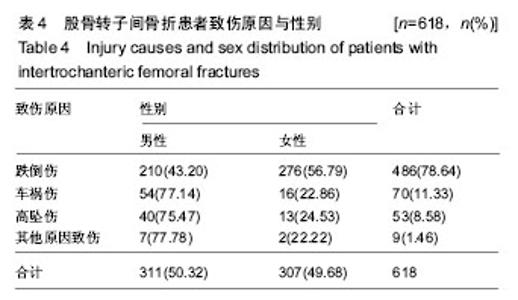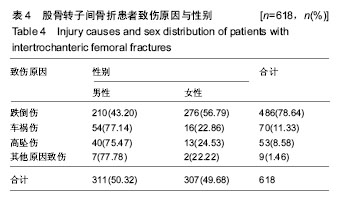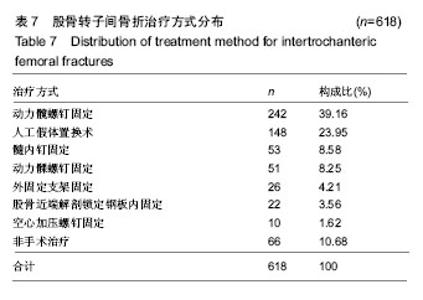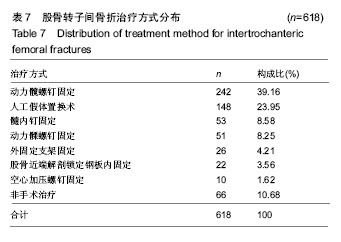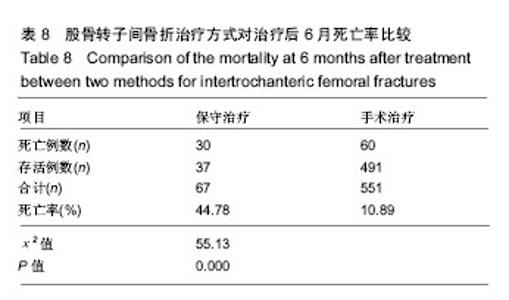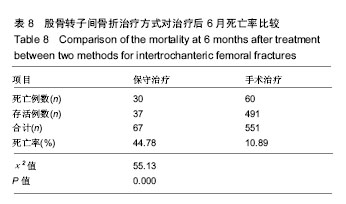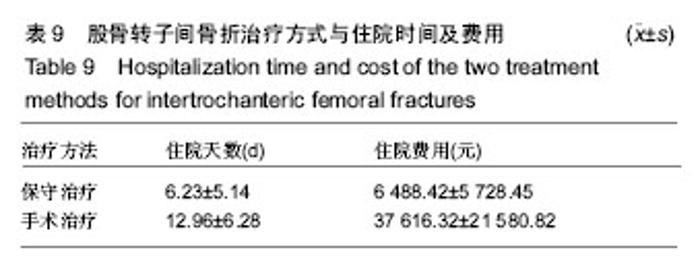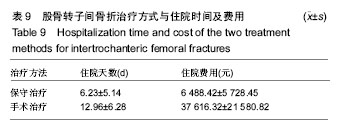Chinese Journal of Tissue Engineering Research ›› 2019, Vol. 23 ›› Issue (12): 1840-1845.doi: 10.3969/j.issn.2095-4344.1110
Previous Articles Next Articles
Intertrochanteric femoral fractures: an epidemiological analysis of 618 cases
Guo Jinchao1, Cao Yuan2, Huang Junling1, Ma Jiajia1, Ma Chuang1
- 1Department of Microscope Repairing, Orthopedic Center, the First Affiliated Hospital of Xinjiang Medical University, Urumqi 830001, Xinjiang Uygur Autonomous Region, China; 2Graduate School of Xinjiang Medical University, Urumqi 830001, Xinjiang Uygur Autonomous Region, China
-
Online:2019-04-28Published:2019-04-28 -
Contact:Ma Chuang, Associate professor, Master’s supervisor, Department of Microscope Repairing, Orthopedic Center, the First Affiliated Hospital of Xinjiang Medical University, Urumqi 830001, Xinjiang Uygur Autonomous Region, China -
About author:Guo Jinchao, Master candidate, Physician, Department of Microscope Repairing, Orthopedic Center, the First Affiliated Hospital of Xinjiang Medical University, Urumqi 830001, Xinjiang Uygur Autonomous Region, China -
Supported by:the National Natural Science Foundation of China, No. 81760397 and 81560350 (to MC)
CLC Number:
Cite this article
Guo Jinchao1, Cao Yuan2, Huang Junling1, Ma Jiajia1, Ma Chuang1. Intertrochanteric femoral fractures: an epidemiological analysis of 618 cases[J]. Chinese Journal of Tissue Engineering Research, 2019, 23(12): 1840-1845.
share this article
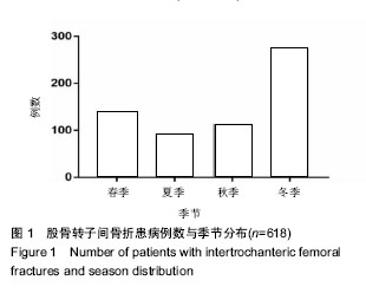
2.1 患者一般情况 符合纳排标准的股骨转子间骨折患者共618例,年龄为1.6-100岁,平均(70.83±15.57)岁,中位数年龄为74岁;其中男性311例,平均(66.87±18.25)岁,女性307例,平均(74.80±10.95)岁,男女比例为1.01∶1;侧别分布:左侧314例,右侧302例,双侧2例,左侧多于右侧(1.04∶1)(双侧为左右侧各1例)。 2.2 时间分布 各年份患病例数分布情况见表1。近11年间,各年度患者的构成比在5.02%-13.59%,2007年占比最低,为5.02%,2013年占比最高,为13.59%。统计结果提示,各年度病例数占比与年份存在正相关关系,但相关性较弱,Kendall’s tau-b=0.203,P值=0.002< 0.05。 2.3 季节分布 新疆地处内陆,气候独特,根据该地区气候特点将其季节划分为春季(4-5月)、夏季(6-8月)、秋季(9-10月)及冬季(11月-次年3月)统计结果可见,冬季患者的例数(44.50%)明显多于其他季节(P < 0.01),其余各季节患病例数差异无统计学意义(P > 0.05)。见图1。 "
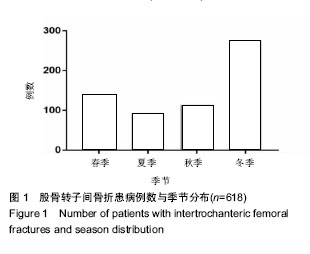
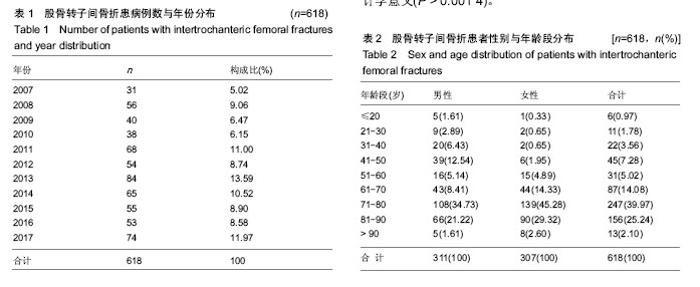
2.4 地区分布 患者主要来源于新疆各地区,其中乌鲁木齐地区最高,共300例(48.54%);其次是昌吉地区,共81例(13.11%);第3位是伊犁哈萨克自治州,共55例(8.90%);此外,非新疆地区患者共29例(4.69%)。 2.5 年龄及性别分布 患者年龄分布范围为1.6-100岁,平均年龄为(70.83±15.57)岁,中位数年龄为74岁。统计分析如表2所示,患者年龄分布差异有统计学意义(P < 0.05)。结果还显示,不同年龄组患者性别分布差异有统计学意义(P < 0.01)。其中≥61岁的女性患者例数均高于男性;而其他年龄段男性患者例数均高于女性。应用χ2分割对各年龄段构成比进行组间比较,将α’< 0.001 4设为新的检验水准。统计分析显示,21-30岁年龄段、31-40岁年龄段、41-50岁年龄段为男性患者显著多于女性(P < 0.001 4)。71-80岁年龄段与81-90岁年龄段为女性患者多于男性患者(P < 0.001 4),其余各年龄段患者性别构成比比较差异均无统计学意义(P > 0.001 4)。"
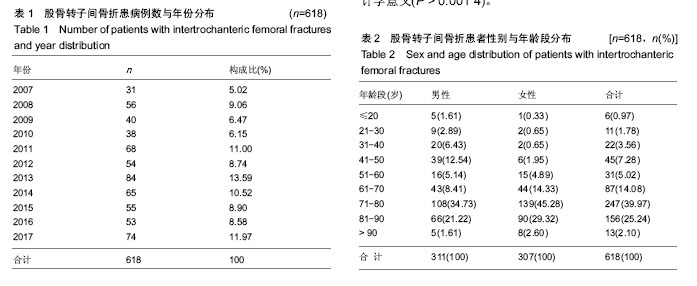
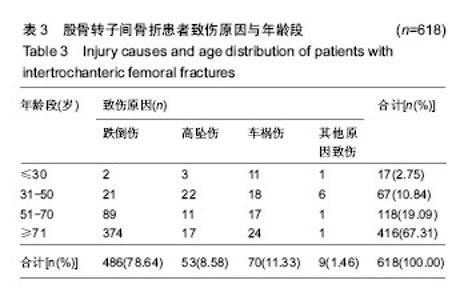
2.6 致伤原因分布 统计分析股骨转子间骨折患者的详细病历资料,将致伤原因分类为“跌倒伤”、“车祸伤”、“高坠伤”及“其他原因致伤”4类。所有致伤原因中,跌倒伤例数最多,共486例(78.64%);其次是车祸伤,共70例(11.33%);第3位是高坠伤,共53例(8.58%);其他原因致伤9例(1.46%)。 2.6.1 年龄与致伤原因分布 将所有患者按年龄分为≤30岁、31-50岁、51-70岁及≥71岁4个年龄段,统计各年龄段各致伤原因例数如表3所示,统计显示,各年龄段的致伤机制分布差异具有统计学意义(P < 0.01)。50岁以下年龄段患者以车祸伤及高坠伤等高能量损伤为主,而51岁及以上年龄段的患者则以跌倒伤等低能量损伤为主。应用χ2分割对各年龄段致伤原因分布进行组间比较,将α’< 0.017设置为新的检验水准。统计显示,≤30岁年龄段和31-50岁年龄段患者致伤原因分布差异无统计学意义(P > 0.017)。其余各年龄段致伤原因分布差异均有统计学意义(P < 0.017)。"
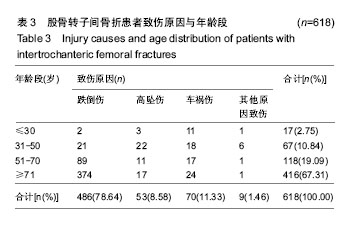
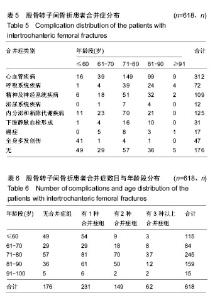
2.7 主要合并症分布 逐一查阅患者病历资料,将患者的合并症按分类为心血管疾病、呼吸系统疾病、精神及神经系统疾病、泌尿系统疾病、内分泌和新陈代谢疾病、下肢深静脉血栓形成、癌症及全身多发创伤等。统计见表5,所有病例中,合并上述疾病任一种及以上的患者占比为71.52%。其中合并心血管疾病的患者病例数最多,占50.49%;内分泌和新陈代谢疾病患者次之,占20.23%。为了进一步分析不同年龄段患者的合并症情况,根据患者各系统疾病分布情况,分为无合并症,有1种合并症、有2种合并症和有3种以上合并症4组。统计结果如表6所示,无合并症组和有1种合并症组中,60岁以下年龄段的患者占比最高;有2种合并症组以71-90岁年龄段的患者为主,而有3种及以上合并症组中以71-80岁和≥91岁两个年龄段的患者为主。 2.8 致伤至手术时间分布 全组手术治疗患者平均致伤至手术的时间为(7.35±5.05) d,最短时间为1 d,最长时间为36 d。其中≤60岁年龄段为(7.38±5.48)d,61-70岁年龄段为(7.59±5.71) d,71-80岁年龄段为(7.53±4.59) d,≥81岁年龄段为(6.91±5.04) d。统计学分析显示各年龄段患者致伤至手术时间分布差异无显著性意义(P > 0.05)。"
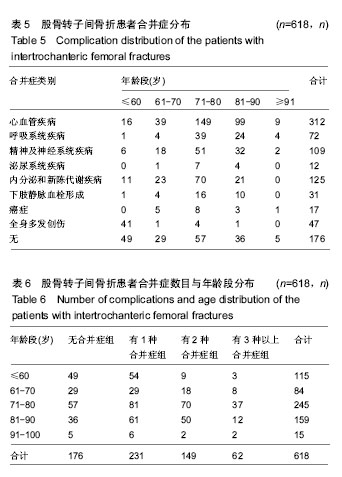
| [1] Sterling RS. Gender and Race/Ethnicity Differences in Hip Fracture Incidence, Morbidity, Mortality, and Function.Clin Orthop Relat Res.2011;469(7):1913-1918.[2] Sambandam SN,Chandrasekharan J,Mounasamy V,et al.Intertrochanteric fractures: a review of fixation methods.Eur J Orthop Surg Traumatol. 2016;26(4):339-353.[3] Hu F, Jiang C, Shen J, et al.Preoperative predictors for mortality following hip fracture surgery: A systematic review and meta-analysis. Injury.2012;43(6):676-685.[4] 梁玉柱,郭洪刚.股骨转子间骨折179例流行病学调查:天津医科大学总医院2013至2015年就诊资料分析[J].中国组织工程研究,2018,22(8): 1167-1172.[5] 姬晨妮,陈伟,朱燕宾,等.京津唐地区1583例老年股骨转子间骨折流行病学特征分析[J].中华老年骨科与康复电子杂志, 2015(1):45-49.[6] 张飞,陈伟,张晓琳,等.成人股骨转子间骨折的临床特点及其变化:单中心3201例分析[J].中华外科杂志, 2014,52(9):697-701.[7] 中国老年医学学会骨与关节分会创伤骨科学术工作委员会.老年髋部骨折诊疗专家共识(2017)[J].中华创伤骨科杂志, 2017,19(11): 921-927.[8] 王长海,马志新,毕力夫.呼和浩特地区髋部骨质疏松性骨折的回顾性研究(附1071例病例分析)[J].中国骨质疏松杂志, 2010,16(3):207-209.[9] 李洪秋,阿良,赵忠海,等.沈阳地区老年髋部骨质疏松性骨折流行病学调查分析[J].中国骨质疏松杂志, 2013,19(3):293-296.[10] 尹英民,林伟龙,沈海敏,等.髋部骨折1266例流行病学调查分析[J].老年医学与保健,2013, 19(3):161-164.[11] Yu J,Tang J,Li Z,et al.History of cardiovascular events and cardiovascular risk factors among patients initiating strontium ranelate for treatment of osteoporosis.Int J Womens Health. 2015;7:913-918.[12] Dennison EM,Syddall HE,Sayer AA,et al.Type 2 diabetes mellitus is associated with increased axial bone density in men and women from the Hertfordshire Cohort Study: evidence for an indirect effect of insulin resistance.Diabetologia.2004; 47(11): 1963-1968.[13] Schwartz AV,Sellmeyer DE,Strotmeyer ES,et al.Diabetes and Bone Loss at the Hip in Older Black and White Adults.J Bone Miner Res. 2005;20(4):596-603.[14] Binks S,Dobson R.Risk Factors, Epidemiology and Treatment Strategies for Metabolic Bone Disease in Patients with Neurological Disease. Curr Osteoporos Rep. 2016;14(5):199-210.[15] Mayor S. Parkinson’s disease diagnosis is preceded by increased risk of falls, study finds.Bmj, 2016;352:i695.[16] Fu MC, Boddapati V, Gausden EB, et al. Surgery for a fracture of the hip within 24 hours of admission is independently associated with reduced short-term post-operative complications.Bone Joint J. 2017; 99-B(9):1216-1222. [17] Sobolev B, Guy P, Sheehan KJ, et al.Mortality effects of timing alternatives for hip fracture surgery. CMAJ. 2018;190(31):E923-E932.[18] 袁志,毕龙.老年股骨转子间骨折的治疗趋势[J].中华骨科杂志, 2017, 37 (17):1057-1060.[19] Mortazavi SM, R Greenky M, Bican O, et al. Total hip arthroplasty after prior surgical treatment of hip fracture is it always challenging. J Arthroplasty. 2012;27(1):31-36.[20] 张晓岗,阿斯哈尔江•买买提依明,曹力,等.非骨水泥型人工关节置换治疗老年不稳定股骨转子间骨折[J]. 中华骨科杂志, 2012,32(7): 631-636.[21] 田雅峰,姚兴豹,杨刚,等.经皮外固定架和PFNA治疗老年高危股骨转子间骨折的临床效果[J].中国医药导报, 2018,15(5):122-126. |
| [1] | Liu Zemin, Lü Xin, Liu Jinyuan, Wang Xiaohu. Epidemiological distribution characteristics of 2 342 cases of hip fracture: a single center analysis [J]. Chinese Journal of Tissue Engineering Research, 2020, 24(32): 5085-5091. |
| [2] | Zhang Shuangyuan, Li Wenjin, Zhu Li, Wang Yu, Wei Zhoudan, Zhao Jiaoyang, Chen Yanan. Meta-analysis of dental implantation success rate in diabetic patients with 6% < glycated hemoglobin level < 8% [J]. Chinese Journal of Tissue Engineering Research, 2020, 24(16): 2620-2624. |
| [3] | Yang Yuan, Zhang Kaibo, Fu Weili, Li Jian. Epidemiology of sports-induced meniscus injury: a systematic review [J]. Chinese Journal of Tissue Engineering Research, 2019, 23(31): 5079-5084. |
| [4] | Liang Yu-zhu1, Guo Hong-gang2. Epidemiological analysis of femoral neck fractures in 179 patients based on the case data from the General Hospital of Tianjin Medical University between 2013 and 2015 [J]. Chinese Journal of Tissue Engineering Research, 2018, 22(8): 1167-1172. |
| [5] | Wan Qian, Yang Xiaohua, Zhang Qingzhu, Feng Zhen, Gu Rui. Curative effects of cemented hemiarthroplasty versus proximal femoral nail anti-rotation for treatment of intertrochanteric fractures of cerebral infarction hemiplegia side in older adults [J]. Chinese Journal of Tissue Engineering Research, 2018, 22(35): 5590-5595. |
| [6] | Lan Tian, Shan Zhan, Wu Jin-chun. Comparison of effects between artificial joint replacement and proximal femoral nail anti-rotation for treatment of unstable intertrochanteric femoral fracture in elderly patients [J]. Chinese Journal of Tissue Engineering Research, 2018, 22(3): 362-367. |
| [7] | Lü Yang, Liu Qi-yu, Liu Jun, Chen Hai-yun, Pan Jian-ke, Li Xi-wen. A meta-analysis of risk factors of postoperative delirium of elderly hip fracture patients in China [J]. Chinese Journal of Tissue Engineering Research, 2018, 22(15): 2437-2445. |
| [8] | Li Xing, Wang Hong-fu, Luo Wei, Cheng Bo, Wang Jun-yuan, Liu Feng. Musculoskeletal multi-body dynamic simulation on patient-specific hip bone after surgery and gait simulation [J]. Chinese Journal of Tissue Engineering Research, 2017, 21(35): 5685-5690. |
| [9] | Hou Li-gang. Biomechanics characteristics of calcar reconstruction using different methods in senile intertrochanteric fractures [J]. Chinese Journal of Tissue Engineering Research, 2017, 21(23): 3616-3621. |
| [10] | Ji Hao-yu. Epidemiological characteristics of 1 638 patients with femoral intertrochanteric fractures in Hohhot [J]. Chinese Journal of Tissue Engineering Research, 2017, 21(16): 2467-2471. |
| [11] | Hu Bing-yan, Ai Jin-wei, Chen Qiong, Yao Zhong-jun . InterTan nail versus proximal femoral nail antirotation for femoral intertrochanteric fractures: a systematic review and meta-analysis [J]. Chinese Journal of Tissue Engineering Research, 2016, 20(53): 8010-8021. |
| [12] | Ren Rong, Li Ling-wei, Guo Qi-fa. Feasibility of implantation of a cemented femoral stem in the treatment of osteoporotic femoral neck fracture in elderly patients: study protocol of a randomized controlled trial [J]. Chinese Journal of Tissue Engineering Research, 2016, 20(48): 7261-7266. |
| [13] |
Xu Jun-jie, Li Ye-hai, Liang Jun-sheng, Liu Qing, Tang Hao-ran, Liu He-feng.
Safety and effectiveness of proximal femoral nail antirotation for the treatment of intertrochanteric femoral fracture: study protocol for a prospective case series
[J]. Chinese Journal of Tissue Engineering Research, 2016, 20(43): 6472-6478.
|
| [14] | Zhang Gui-tong, Feng Jie-yang, Liu Jia, Zhang Yan-jin, Xiang Zi-min, Meng Fan-xing,Sun Tian-sheng. Protective effect of bone marrow stromal stem cells against acute lung injury after hip fracture in aged rats with chronic obstructive pulmonary disease [J]. Chinese Journal of Tissue Engineering Research, 2016, 20(28): 4189-4195. |
| [15] | Wang Xin . Meta-analysis of death risk factors for hip fracture in the elderly [J]. Chinese Journal of Tissue Engineering Research, 2016, 20(26): 3929-3937. |
| Viewed | ||||||
|
Full text |
|
|||||
|
Abstract |
|
|||||
